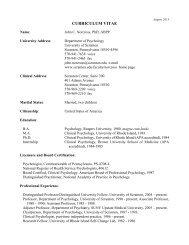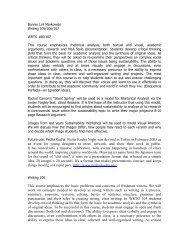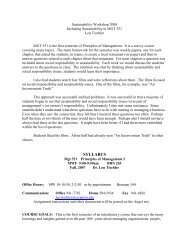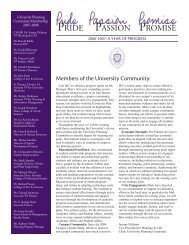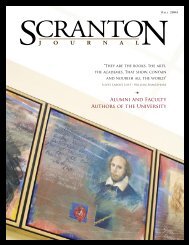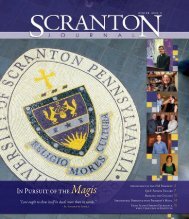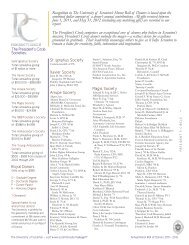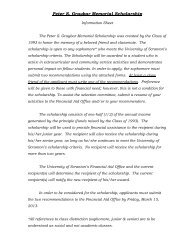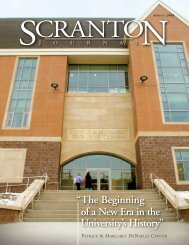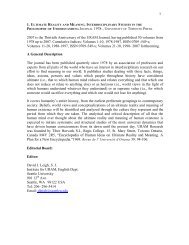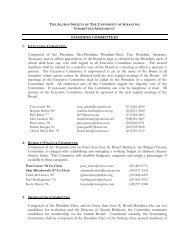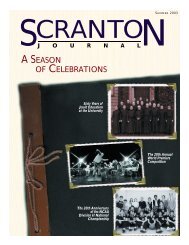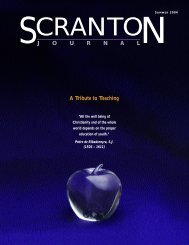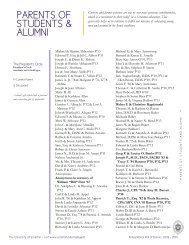winter 2009-2010 - The University of Scranton
winter 2009-2010 - The University of Scranton
winter 2009-2010 - The University of Scranton
Create successful ePaper yourself
Turn your PDF publications into a flip-book with our unique Google optimized e-Paper software.
60 ▼<br />
Major General John Herrling<br />
Duty and Commitment<br />
Shape a Life <strong>of</strong> Service<br />
John P. Herrling ’60 didn’t figure<br />
on a 35-year career in the Army.<br />
<strong>The</strong> ROTC student and psychology<br />
major thought he’d do three<br />
years as a commissioned <strong>of</strong>ficer in<br />
Europe and then return to the States<br />
to a job in New York. When he told<br />
one <strong>of</strong> his Jesuit pr<strong>of</strong>essors <strong>of</strong> his plans, the<br />
response was, perhaps, a bit encouraging.<br />
“That’s good,” the priest said. “We need<br />
good Army <strong>of</strong>ficers.”<br />
Herrling ended up extending his original<br />
three-year hitch into a 35-year active-duty<br />
career <strong>of</strong> uncommon distinction. His service<br />
included two tours in Vietnam, repeated<br />
tours to Europe during the Cold War, and<br />
a final rank <strong>of</strong> major general. Over the<br />
years he was recognized with the Defense<br />
Distinguished Service Medal, the Army<br />
Distinguished Service Medal, the Silver Star,<br />
the Legion <strong>of</strong> Merit (with Oak Leaf Cluster),<br />
the Bronze Star Medal (with two Oak<br />
Leaf Clusters), and a Purple Heart, among<br />
other decorations and awards. Herrling cites<br />
the dedication and commitment <strong>of</strong> the service<br />
people he met during his first tour in<br />
Europe as inspiring him to remain in the<br />
Major General John Herrling ’60 (left) is<br />
greeted by President Bill Clinton at a White<br />
House reception during the building <strong>of</strong> the<br />
National World War II Memorial.<br />
Army, though you have to wonder whether<br />
the quiet encouragement he received on<br />
campus just before graduating also had<br />
something to do with it.<br />
“I’ve always appreciated the education I<br />
received at the <strong>University</strong>,” he says. “It’s just a<br />
first-class education. And not only the education<br />
part: <strong>The</strong> Jesuits teach you a way to live<br />
your life, to make your life more meaningful,<br />
and how to experience a fuller life. <strong>The</strong> Jesuits<br />
teach you not only the academic part <strong>of</strong> your<br />
education, but how to be good citizens; how<br />
to act responsibly in the interest <strong>of</strong> others;<br />
and ethics and moral conduct<br />
to guide your life.”<br />
General Herrling’s contributions<br />
didn’t end with his<br />
retirement from active duty<br />
in 1995. That year President<br />
Clinton named him Secretary<br />
<strong>of</strong> the American Battle<br />
Monuments Commission,<br />
which commemorates the<br />
service, achievements, and<br />
sacrifice <strong>of</strong> American armed<br />
forces both overseas and stateside. While<br />
in that position one <strong>of</strong> General Herrling’s<br />
primary responsibilities was to build<br />
<strong>The</strong> National World War II Memorial in<br />
Washington, D.C. His current position is<br />
with the National Army Museum Campaign,<br />
which is raising funds to support<br />
the construction <strong>of</strong> the National Museum<br />
<strong>of</strong> the United States Army, to be located<br />
at Fort Belvoir, VA, just outside <strong>of</strong> Washington,<br />
D.C. General Herrling is<br />
serving as the campaign executive<br />
director.<br />
Duty and commitment are<br />
obvious benchmarks, and not only<br />
to his country. A three-year starter<br />
at end on <strong>Scranton</strong>’s football squad,<br />
General Herrling has stayed connected<br />
to the <strong>University</strong> over<br />
the decades by attending both class and<br />
team reunions.<br />
“Over all those years I was in the service,<br />
I could always look back and say my real<br />
development and the understanding <strong>of</strong><br />
who I was took place at <strong>Scranton</strong>,” he says.<br />
“That’s always stayed with me over the years.<br />
Even when I was overseas, I always maintained<br />
that connection with <strong>Scranton</strong>. <strong>The</strong><br />
<strong>University</strong> has been a touchstone in my life<br />
and it got me <strong>of</strong>f on the right path.”<br />
Indeed, General Herrling sees a strong link<br />
between the kind <strong>of</strong> responsible citizenship<br />
nurtured at the <strong>University</strong> and his own lifelong<br />
immersion in promoting the general welfare<br />
and common defense <strong>of</strong> his fellow Americans.<br />
He speaks <strong>of</strong> these facets <strong>of</strong> his life as one<br />
might discuss a mission or a calling.<br />
“Each <strong>of</strong> us has our individual responsibility<br />
to do what we can to improve the country<br />
and to improve people. That’s all part <strong>of</strong> the<br />
Jesuit philosophy,” General Herrling says. “I<br />
could do my part in the Army, and if I did it<br />
well enough I would influence other people<br />
to do their part as far as their civic responsibility<br />
to the country and themselves.”<br />
21<br />
Generations <strong>of</strong> Alumni Keep the <strong>Scranton</strong> Legacy Alive



